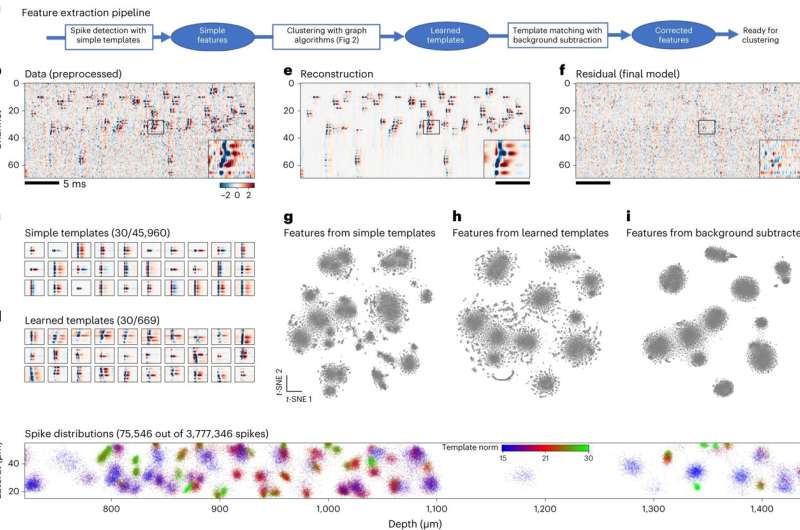This article has been reviewed according to Science X's editorial process and policies. Editors have highlighted the following attributes while ensuring the content's credibility:
fact-checked
peer-reviewed publication
trusted source
proofread
Neuroscientists release state-of-the-art spike-sorting software

How do researchers make sense of the mountains of data collected from recording the simultaneous activity of hundreds of neurons? Neuroscientists all over the world rely on Kilosort, software that enables them to tease apart spikes from individual neurons to understand how the brain's cells and circuits work together to process information.
Now, researchers at HHMI's Janelia Research Campus, led by Group Leader Marius Pachitariu, have released Kilosort4, an updated version of the popular spike-sorting software that has improved processing, requires less manual work, and is more accurate and easier to use than previous versions.
"Over the past eight years, I've been refining the algorithm to make it more and more human-independent so people can use it out of the box," Pachitariu says.
Kilosort has become indispensable for many neuroscientists, but it may never have been developed if Pachitariu hadn't decided he wanted to try something new.
Pachitariu's Ph.D. work was in computational neuroscience and machine learning, but he yearned to work on more real-world applications, and he almost left academia for industry after he completed his Ph.D. Instead, Pachitariu opted for a postdoc in the joint lab of Kenneth Harris and Matteo Carandini at University College London, where he could do more experimental neuroscience.
The lab was then part of a consortium testing a probe called Neuropixels, developed at HHMI's Janelia Research Campus. Pachitariu had no idea how to use the probes, which record activity from hundreds of neurons simultaneously, but he knew how to develop algorithms to keep up with the enormous amount of data his labmates were generating.
In the first year of his postdoc, Pachitariu developed the initial version of Kilosort. The software, which was 50 times faster than previous approaches, allowed researchers to process the millions of data points generated by the Neuropixels probes. Eight years later, the probes and the software are staples in neuroscience labs worldwide, allowing researchers to identify and classify the spikes of individual neurons.
In 2017, Pachitariu became a group leader at Janelia, where he and his team seek to understand how thousands of neurons work together to enable animals to think, decide, and act. These days, Pachitariu spends most of his time doing experiments and analyzing data, but he still finds time to work on improving Kilosort. The newly released Kilosort4 is the best in its class, outperforming other algorithms and correctly identifying even hard-to-detect neurons, according to the researchers.
Pachitariu says it is much easier to squeeze in work on projects like Kilosort at Janelia than at other institutions where he would have to spend time writing grants and teaching.
"Every now and then, I can put a few months into spearheading a new version and writing new code," he says.
Pachitariu says he also enjoys refining Kilosort, which allows him to use the core set of skills he developed during his Ph.D. work.
"I enjoy doing it, and I know it is useful to other people so that always helps in motivating me," he says.
The paper is published in the journal Nature Methods.
More information: Marius Pachitariu et al, Spike sorting with Kilosort4, Nature Methods (2024). DOI: 10.1038/s41592-024-02232-7



















